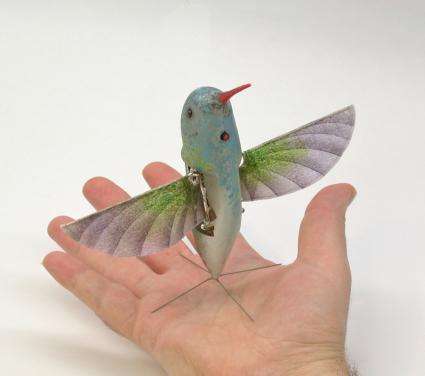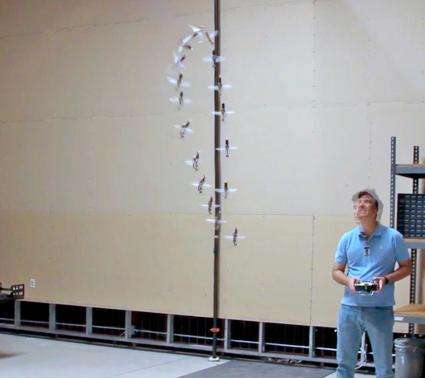February 18, 2011 report
Robot hummingbird passes flight tests (w/ Video)

(PhysOrg.com) -- A prototype robot spy "ornithopter," the Nano-Hummingbird, has successfully completed flight trials in California. Developed by the company AeroVironment Inc., the miniature spybot looks like a hummingbird complete with flapping wings, and is only slightly larger and heavier than most hummingbirds, but smaller than the largest species.
The Hummingbird's bird-shaped body is removable but it gives the bot an uncanny resemblance to a real hummingbird. The vehicle can hover and maneuver just like the bird.
The ornithopter can fly into buildings under the control of an operator flying the spybot with the help of a feed from its tiny video camera. The prototype is capable of flying at speeds of up to 18 km/h (11 mph) and weighs 19 grams, which is about the same as an AA battery.
Manager of the project, Matt Keennon, said it had been a challenge to design and build the spybot because it “pushes the limitations of aerodynamics.” The specifications given to the firm by the Pentagon included being able to hover in an 8 km/h wind gust and being able to fly in and out of buildings via a normal door.
The spybot was developed for the US military's research arm, the Defense Advanced Research Projects Agency (DARPA). The hummingbird appearance is intended to disguise the bot, although it would look decidedly out of place and would attract attention in most places in the world since hummingbirds are not found outside of the Americas.
DARPA's head of the Nano Air Vehicles (NAV) program. Dr Todd Hylton, said the successful flight tests pave the way for new vehicles that resemble small birds and match their agility. The new drone is a departure from existing NAVs, which in the past have always resembled helicopters or planes.

The current model is a prototype and more development is required before any decisions are made on its deployment. Keennon said he expected the flight time to improve as the spybot develops, and said he envisaged it could be used for reconnaissance purposes in around a decade. He also said the final version is unlikely to look like a hummingbird, which is rare even in parts of the US, and he thinks a sparrow would be a better choice.
The US military has funded the project, giving AeroVironment around $4 million since 2006.
More information: www.avinc.com/nano
© 2010 PhysOrg.com


















